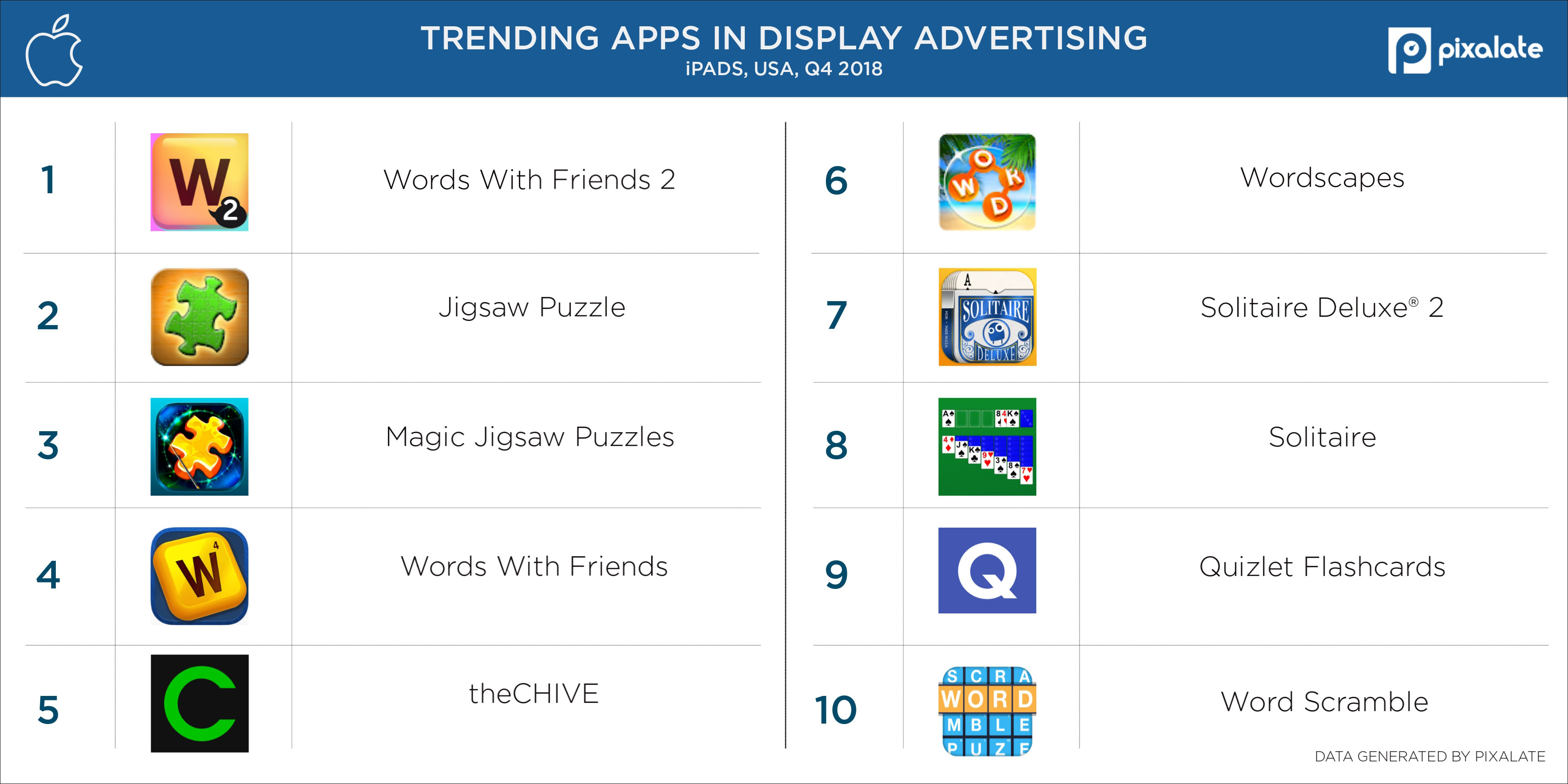
Pixalate monitors billions of mobile in-app programmatic advertising transactions to identify which apps are trending at any given moment. We publish quarterly updates on trending apps across iOS (phones and tablets) and Android (phones and tablets).
This post highlights the top 10 trending iPad apps in the United States, based on display and video programmatic advertising volume, in Q4 2018. To see the most recent top 30 apps, download the list here:
Key takeaways:
Games accounted for eight of the top 10 spots for iPad display advertising in Q4 2018
All eight were either word games, puzzle games, or solitaire games
Quizlet ranked in the top 10 for display advertising as students studied up for the fall semester
Viggle, a TV companion app, ranked in the top 10 for video advertising as viewers watched new fall TV shows
.jpg?width=600&name=Display-iOS-tablets-US-share-of-voice-(Q4-2018).jpg)
Games accounted for eight of the top 10 spots for iPad display advertising in Q4 2018
Word games (four of them), Puzzle games (two of them), and Card games (two of them) accounted for all of the gaming apps in the top 10
theCHIVE, an entertainment app, and Quizlet, an Education app, were the only two non-games in the top 10
.jpg?width=600&name=Video-iOS-tablets-US-share-of-voice-(Q4-2018).jpg)
Seven of the top 10 iPad apps for video advertising were Games
Viggle, a TV companion app, ranked in the top 10 for video advertising as viewers watched new fall TV shows
With midterm elections in Q4 2018, HuffPost - News & Politics ranked in the top 10 for iPad video advertising
To see the most recent top 30 apps, download the list here:
Want more information about trending apps? See our App Trends Reports, which reveal the latest trending apps based on a variety of key signals important to advertisers, including Breakout App, Viewability, Unique Visitor, Active User, Incentivized App, Downloads, and Share of Voice.
Note: Any reference to "top" or "trending" apps refers solely to an app's Share of Voice of programmatic advertising impressions as measured by Pixalate.
DISCLAIMER: Pixalate's iPad App Trends reports present ratings and rankings for the top iPad apps according to a number of categories. These categories reflect Pixalate's opinions with respect to factors that Pixalate believes will be of value to purchasers or sellers of in-app digital advertising inventory, advertisers and agencies representing advertisers, and publishers of such apps or competitive offerings. The scores or ratings in each category reflect Pixalate’s opinions regarding the performance of each iPad application with respect to each particular category. The rankings reflect Pixalate's opinions regarding the relative performance of each iPad application with respect to these categories. Pixalate's opinions are just that – opinions, not facts or guarantees – but they are grounded in its proprietary technology and analytics, which Pixalate is continuously evaluating and updating.
*By entering your email address and clicking Subscribe, you are agreeing to our Terms of Use and Privacy Policy.
These Stories on Mobile
*By entering your email address and clicking Subscribe, you are agreeing to our Terms of Use and Privacy Policy.

Disclaimer: The content of this page reflects Pixalate’s opinions with respect to the factors that Pixalate believes can be useful to the digital media industry. Any proprietary data shared is grounded in Pixalate’s proprietary technology and analytics, which Pixalate is continuously evaluating and updating. Any references to outside sources should not be construed as endorsements. Pixalate’s opinions are just that - opinion, not facts or guarantees.
Per the MRC, “'Fraud' is not intended to represent fraud as defined in various laws, statutes and ordinances or as conventionally used in U.S. Court or other legal proceedings, but rather a custom definition strictly for advertising measurement purposes. Also per the MRC, “‘Invalid Traffic’ is defined generally as traffic that does not meet certain ad serving quality or completeness criteria, or otherwise does not represent legitimate ad traffic that should be included in measurement counts. Among the reasons why ad traffic may be deemed invalid is it is a result of non-human traffic (spiders, bots, etc.), or activity designed to produce fraudulent traffic.”

